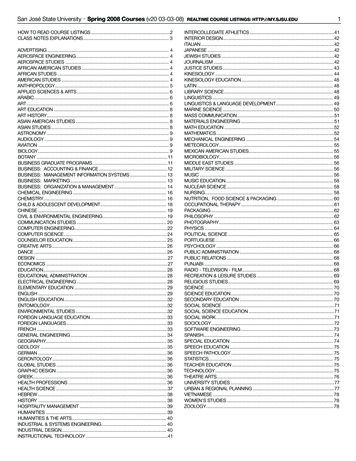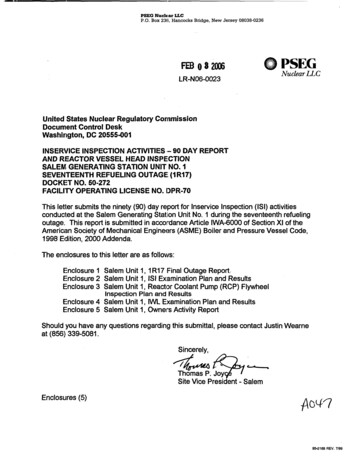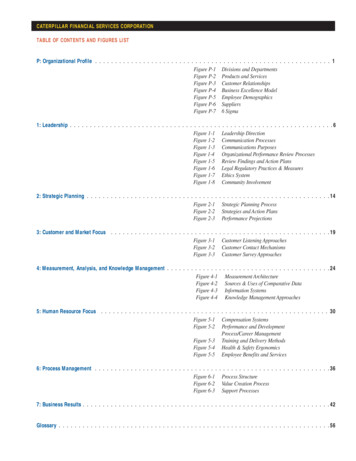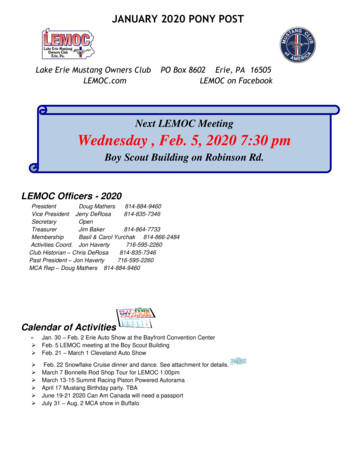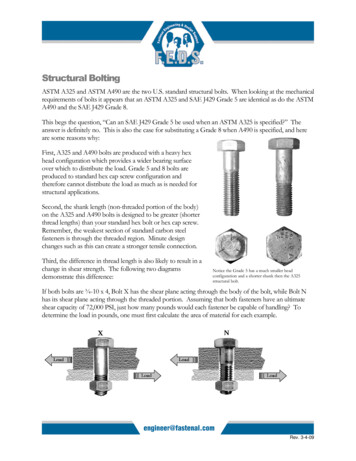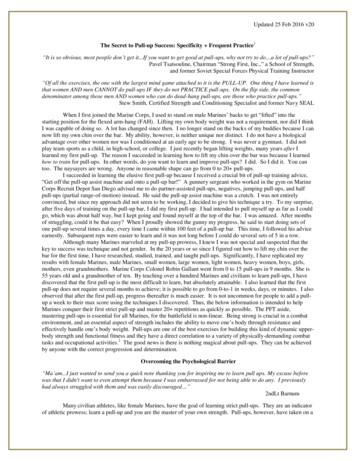
Transcription
Updated 25 Feb 2016 v20The Secret to Pull-up Success: Specificity Frequent Practice1“It is so obvious, most people don’t get it.If you want to get good at pull-ups, why not try to do a lot of pull-ups?”Pavel Tsatsouline, Chairman “Strong First, Inc.,” a School of Strength,and former Soviet Special Forces Physical Training Instructor“Of all the exercises, the one with the largest mind game attached to it is the PULL-UP. One thing I have learned isthat women AND men CANNOT do pull-ups IF they do not PRACTICE pull-ups. On the flip side, the commondenominator among those men AND women who can do dead-hang pull-ups, are those who practice pull-ups.”Stew Smith, Certified Strength and Conditioning Specialist and former Navy SEALWhen I first joined the Marine Corps, I used to stand on male Marines’ backs to get “lifted” into thestarting position for the flexed arm-hang (FAH). Lifting my own body weight was not a requirement, nor did I thinkI was capable of doing so. A lot has changed since then. I no longer stand on the backs of my buddies because I cannow lift my own chin over the bar. My ability, however, is neither unique nor distinct. I do not have a biologicaladvantage over other women nor was I conditioned at an early age to be strong. I was never a gymnast. I did notplay team sports as a child, in high-school, or college. I just recently began lifting weights, many years after Ilearned my first pull-up. The reason I succeeded in learning how to lift my chin over the bar was because I learnedhow to train for pull-ups. In other words, do you want to learn and improve pull-ups? I did. So I did it. You cantoo. The naysayers are wrong. Anyone in reasonable shape can go from 0 to 20 pull-ups.I succeeded in learning the elusive first pull-up because I received a crucial bit of pull-up training advice,“Get off the pull-up assist machine and onto a pull-up bar!” A gunnery sergeant who worked in the gym on MarineCorps Recruit Depot San Diego advised me to do partner-assisted pull-ups, negatives, jumping pull-ups, and halfpull-ups (partial range-of-motion) instead. He said the pull-up assist machine was a crutch. I was not entirelyconvinced, but since my approach did not seem to be working, I decided to give his technique a try. To my surprise,after five days of training on the pull-up bar, I did my first pull-up. I had intended to pull myself up as far as I couldgo, which was about half way, but I kept going and found myself at the top of the bar. I was amazed. After monthsof struggling, could it be that easy? When I proudly showed the gunny my progress, he said to start doing sets ofone pull-up several times a day, every time I came within 100 feet of a pull-up bar. This time, I followed his adviceearnestly. Subsequent reps were easier to learn and it was not long before I could do several sets of 5 in a row.Although many Marines marveled at my pull-up prowess, I knew I was not special and suspected that thekey to success was technique and not gender. In the 20 years or so since I figured out how to lift my chin over thebar for the first time, I have researched, studied, trained, and taught pull-ups. Significantly, I have replicated myresults with female Marines, male Marines, small women, large women, light women, heavy women, boys, girls,mothers, even grandmothers. Marine Corps Colonel Robin Gallant went from 0 to 15 pull-ups in 9 months. She is55 years old and a grandmother of ten. By teaching over a hundred Marines and civilians to learn pull-ups, I havediscovered that the first pull-up is the most difficult to learn, but absolutely attainable. I also learned that the firstpull-up does not require several months to achieve; it is possible to go from 0-to-1 in weeks, days, or minutes. I alsoobserved that after the first pull-up, progress thereafter is much easier. It is not uncommon for people to add a pullup a week to their max score using the techniques I discovered. Thus, the below information is intended to helpMarines conquer their first strict pull-up and master 20 repetitions as quickly as possible. The PFT aside,mastering pull-ups is essential for all Marines, for the battlefield is non-linear. Being strong is crucial in a combatenvironment, and an essential aspect of strength includes the ability to move one’s body through resistance andeffectively handle one’s body weight. Pull-ups are one of the best exercises for building this kind of dynamic upperbody strength and functional fitness and they have a direct correlation to a variety of physically-demanding combattasks and occupational activities.2 The good news is there is nothing magical about pull-ups. They can be achievedby anyone with the correct progression and determination.Overcoming the Psychological Barrier“Ma’am.I just wanted to send you a quick note thanking you for inspiring me to learn pull ups. My excuse beforewas that I didn't want to even attempt them because I was embarrassed for not being able to do any. I previouslyhad always struggled with them and was easily discouraged ”2ndLt BarnumMany civilian athletes, like female Marines, have the goal of learning strict pull-ups. They are an indicatorof athletic prowess; learn a pull-up and you are the master of your own strength. Pull-ups, however, have taken on a
mystique all their own. The reason is learning to perform even one repetition usually requires specific skill-work,which is not the case with most other exercises, such as the push-up. Thus, even though pull-ups are a “learnedskill” rather than an “innate capability,” women often believe they cannot learn one pull-up—let alone twenty. Forfemale Marines, this psychological barrier is partially due to the existence of the 40 year-old requirement to performthe FAH on the physical fitness test (PFT). The FAH has created a false perception of women’s physical potential.Many think that physical weakness is their natural and irreversible condition. The belief that the average woman isincapable of lifting her own body weight is why some individuals oppose the Marine Corps’ decision to transition topull-ups for female Marines—they think it is unfair. This erroneous belief is deepened when they observe somefemale Marines train diligently but struggle to do one pull-up. On the other hand, people expect men to do pull-ups.Male Marines have been required to perform pull-ups since the 1950s. When a man cannot do a pull-up, it isbecause he is weak. When a woman cannot do a pull-up, it is because she is a woman.Yet if women cannot do pull-ups, why are there women doing pull-ups? Most people’s explanation is thatthese women are hard-charging anomalies—deviations from the norm, exceptions to the rule. This belief begs thequestion: What makes the women who can do pull-ups different from the women who cannot? Women are not sophysically different from each other, after all. Rather than give the incongruity serious thought, most people shrugtheir shoulders and categorize the accomplishments of strong women as “abnormal.” When faced with growingevidence that the average woman can do pull-ups, however, some people strengthen their belief that it is unfair torequire pull-ups of female Marines—pull-ups are too difficult and take too long for women to learn; it is too difficultfor older women and mothers to learn pull-ups. The problem is that these beliefs are all untrue. Women of all agesand sizes can learn pull-ups, and it does not take as long as one might think. Thus, a woman performing pull-ups isnot an “exception” to the rule that women are naturally and irreversibly weak. She is simply closer to her athleticpotential than other women because the learned how to train. Thus, the answer to the incongruity—why somewomen can do pull-ups and some women cannot—is their training.Fortunately, the gradual accumulation of physical performance data demonstrates that women can performpull-ups and the paradigm is finally changing. Once a female Marine overcomes the psychological barrier, however,there still remains training obstacles, which can be harder to negotiate. There is an absence of useful informationand an abundance of training misconceptions when it comes to starting with zero pull-ups. For example, twopopular and effective pull-up programs—Recon Ron and The Armstrong Method—do not include instructions forhow to go from zero-to-one pull-up. Why should they? They were written for male Marines who can already do atleast three pull-ups. For the above reasons, the material below identifies training pit-falls and offers potentialsolutions for how to conquer the elusive first pull-up.Negotiating Training Obstacles“I bought my own pull up bar for my room and have been consistently practicing ”2ndLt BarnumWhen it comes to pull-ups, most people know that the key to improving is to simply do pull-ups. Thereinlays the conundrum. How does a person practice pull-ups when one cannot do pull-ups? A solution is to performvertical raising and lowering exercises on a pull-up bar using gravity and one’s own body weight to train. I callthese exercises “pull-up progressions.” Training on a bar with just your body weight and gravity builds strength inthe exact muscles required for the pull-up while simultaneously training your nerves, ligaments, muscles, tendons,and central nervous system the mechanics of a pull-up. Thus, you train muscles through “movement” rather than“isolation.” Training muscles through movement is essential for functional fitness and especially important forlearning pull-ups. Most people—Marines included—are not aware of this fact. Many erroneously assume theycannot or should not train on a pull-up bar until they can perform at least one unassisted pull-up and consequentlybanish themselves from the piece of equipment that is most helpful to their success. Complicating matters, mostpull-up novices do not come to these conclusions on their own. It is not uncommon for them to receive trainingadvice from fitness coaches, personal trainers, and people who can already do pull-ups, such as “Do lat pull-downsuntil you can do a pull-up.” Most of these people did not learn pull-ups from zero, however. Consequently, they arenot necessarily familiar with the best techniques to go from zero-to-one.As a result of this misconception, there are a couple of approaches individuals often take to try and conquerpull-ups. The first is to focus their strength training on their pull-up muscles—their forearms, biceps, shoulders,lats, back, and mid-section. Accordingly, these people tend to spend time in the gym doing exercises such as pushups, ring-rows, bicep curls, bench press, lateral pull-downs, planks, etc. The problem with this approach is theyisolate each muscle group, but the pull-up exercise requires the pull-up muscles to work together in coordination.
The central nervous system needs to learn the “motor pattern” of the pull-up in order to know what to tell themuscles to do. That is not to say that targeting the pull-up muscles during strength training is not beneficial. Thereis simply more skill transfer to learning pull-ups by performing vertical pull-up progressions. Push-ups and ringrows, for example, place the athlete in a horizontal rather than vertical position. As such, these exercises should notreplace skill work on a pull-up bar if a person has the goal of learning or improving strict pull-ups. Matter of fact, ifthese kinds of exercises are used as the sole means for learning a pull-up, a person may not reach his or her goal. Assuch, I consider these exercises to be “supplementary” exercises, not pull-up progressions. Personal trainer TonyGentilcore stated it more simply, “There are plenty of guys out there who can crush ten reps equivalent to theirbodyweight on the bench press yet often struggle performing one pull-up.” In other words, moving one’s bodyweight is a skill that requires specific practice moving one’s body weight.The second approach people often take to learning their first strict pull-up is to use pull-up assist machinesand pull-up bands. On the surface, this approach appears advisable because it seems to be training the motor patternof the pull-up. It is also logical to use these devices because this is precisely the purpose for which they weredesigned. The pull-up assist machine uses a counter-weight to reduce lifting resistance, thereby allowing a person topull up only a fraction of his or her body weight. Pull-up bands also reduce lifting resistance. The idea is to liftmore weight in gradual intervals over time, with the goal to eventually lift 100% body weight. Nonetheless, eventhough these devices mimic the motor pattern of a pull-up, it does not mean they are particularly effective. Rather,they are suboptimal for many people because they provide too much assistance at the wrong time and they ignoresome of the pull-up muscles. The pull-up assist machine, in particular, recruits a slightly different motor patternthan strict pull-ups. It places the individual in a fixed position and does not require the use of core stabilizers (abs)during performance of the exercise. It more resembles a lateral pull-down than a pull-up. The bands are slightlybetter than pull-up assist machines because they require an athlete to train on a pull-up bar. They negate the need topull the shoulder blades down and back when initiating a pull-up, however, which is one of the most difficult partsof the pull-up to learn. They also allow individuals to bounce out of the bottom position of the pull-up. Essentially,neither piece of equipment adequately replicates the motor pattern of the pull-up and both allow athletes toinadvertently cheat their pull-up training.Another reason pull-up assist machines and bands are largely ineffective is because some people becomeoverly-reliant on the assistance and are reluctant to give up the support. Additionally, many people use them as theirsole means for working the pull-up movement pattern. Typically, the only time they mount a pull-up ba
pull-up does not require several months to achieve; it is possible to go from 0-to-1 in weeks, days, or minutes. I also observed that after the first pull-up, progress thereafter is much easier .


